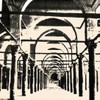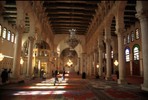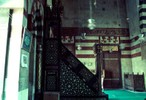Previous Lecture | Next Lecture
Concepts
Quraysh: The tribe of the Prophet and inhabitants of Mecca who controlled the Ka`ba and the lucrative north-south trade between Yemen and the Byzantine empire.
`Ali: Cousin of the Prophet and second Muslim. He later became Muhammad's son-in-law and fourth successor (caliph).
Medina: Formerly Yathrib, the capital of the Prophet where the prototypical mosque, the Mosque of the Prophet, was founded in the year 1 Hegire (or Immigration)/ 622 A.D.
`Amru ibn al-`As: The Muslim general and statesman who conquered Egypt in 640-41.
Babylon: The Roman fortress which stood on the eastern bank of the Nile and guarded the head of the delta.
Fustat: The first capital of Islamic Egypt established in 642 by `Amru to the south, east, and north of Babylon and probably named after the Roman military term fossatum, or encampment.
Khitta: A parcel of land in a Misr given to a group from the various tribes that constituted the Islamic army to build their dwellings on.
Qibla: The direction of Mecca toward which Muslims are required to face when they pray.
Monuments
Mecca
The holiest Islamic city in Arabia and the birthplace of the Prophet Muhammad, where the Ka`ba is located (date of building unknown). Interior view of the prayer hall of the Mosque of `Amru.
The Elements of a Mosque: The Hypostyle Mosque
Mosque in which the prayer hall is formed of rows of vertical supports that can multiply indefinitely. It was the dominant type in the early Islamic period and may have started with the Mosque of the Prophet in Medina (begun in 622) whose prayer hall was a hypostyle supported on palm tree trunks.
Mihrab
A recess, mostly in the form of arched niche, in the qibla wall, facing the direction toward Mecca.
Minbar
A pulpit near the mihrab, from which the prayer leader gives the sermon on Fridays.
Minaret
A tower, circular, octagonal, or square in section, built next to or in a mosque, from which the Muslims are called to prayer.
Nilometr at Rawda Island
It consists of a graded marble column in the middle of a well connected to the Nile through tunnels dug on three levels topped by a light conical dome. The walls of the well are decorated with beautifully carved Kufic Qur'anic inscriptions referring to water, prosperity, and vegetation, and therefore playing an iconographic role in this crucial structure for the understanding of the economic and social history of Egypt.






